|
GOLFITO
Golfito in its heyday was the largest exporter of bananas
on the West Coast. It has a large very protected natural bay located within
Golfo Dulce on the Southern Western Coast of Costa Rica. Itís not known as a
tourist destination but is on the list for many cruisers. Itís a safe haven for
yachters to rest, and mingle with others of their kind in this remote cruising
area. All the yachters know the Banana Bay Marina. You canít miss it as you
enter the harbor; itís painted a brilliant bright yellow.
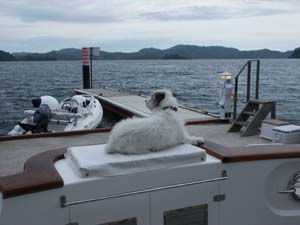 An Expat owns it, a
young guy in his 30ís, and he provides all the conveniences for cruisers that
they havenít been able to get for a very long haul on this coast. The wooden
docks are a bit rickety and they have a simple open-air restaurant and bar that
looks a little worn. But he provides a warm welcome like youíve reached home
and the pluses are Internet services, fuel, power, water, a few simple rooms to
rent and a couple hot tubs right next to the restaurant/bar. We didnít head for
Banana Bay though as we couldnít get a confirmation back on email to reserve a
slip space. We headed instead at a brand new marina next door called K&B. We
had heard about K& B from a sports fisher in Los Suenos. It was the new upscale
version with concrete docks and tin roof that covered the dock paths, power to
blast off, water, and fine dining and the prettiest girls to run the bar and
restaurant service that Iíve seen since weíve come South of the border. The
restaurant had only been open 3 days when we arrived. K&B claims itís not in
competition with Banana Bay but the longer our stay the more we sensed some
tension between the two and their local followers, though we canít put our
finger on it. An Expat owns it, a
young guy in his 30ís, and he provides all the conveniences for cruisers that
they havenít been able to get for a very long haul on this coast. The wooden
docks are a bit rickety and they have a simple open-air restaurant and bar that
looks a little worn. But he provides a warm welcome like youíve reached home
and the pluses are Internet services, fuel, power, water, a few simple rooms to
rent and a couple hot tubs right next to the restaurant/bar. We didnít head for
Banana Bay though as we couldnít get a confirmation back on email to reserve a
slip space. We headed instead at a brand new marina next door called K&B. We
had heard about K& B from a sports fisher in Los Suenos. It was the new upscale
version with concrete docks and tin roof that covered the dock paths, power to
blast off, water, and fine dining and the prettiest girls to run the bar and
restaurant service that Iíve seen since weíve come South of the border. The
restaurant had only been open 3 days when we arrived. K&B claims itís not in
competition with Banana Bay but the longer our stay the more we sensed some
tension between the two and their local followers, though we canít put our
finger on it.
As we entered the bay, you must line up the boat with
markers strategically placed in the jungle-covered hills at the entrance. I
suppose this is meant more for the large freighters that come into this port.
They still have the old pier that was used for the United Fruit Company for
their banana trade through most of the 1900ís. We gave way to one huge
freighter coming out as we entered the channel. We made our turn towards the
marina and saw several dock hands waiting to take our lines but it looked much
easier than it was. There are huge 15-foot tides here and we happened to enter
during the incoming or out coming (I canít remember) tide. It pushed the boat
in squirrelly directions. It took Larry three stressful tries to get into the
slip and all the help of the very capable dockhands. They tied that boat up
better than weíve seen it tied since the boat was commissioned. Larry did a
great job considering that Capt Rains had been doing all the docking up to this
point. Larry and I had the job of learning the lines and fenders, and docking
starting in Costa Rica. This was our first docking since we left Dana Point.
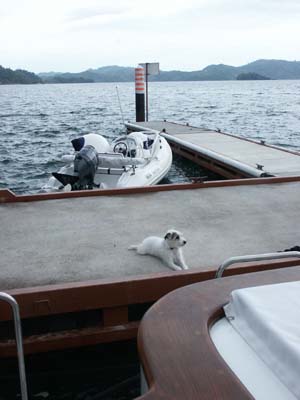 The small marina (it had only one pier) was really the
nicest thing weíve seen since Los Suenos though not on the same scale. A young
man (Steve) from Maine runs the place. Heís a tall nice looking guy and was
busy taking care of his two daughters, the family dog, running the small marina,
and showing us all the facilities. He was a former mechanical engineer for
tugboats in Maine and Massachusetts. He said a money backer offered he and his
family the opportunity to build this marina and live down here. His wife was
away in Maine on our visit taking care of final arrangements on the sale of
their house. Steve said he and three guys built every piece of the marina,
which included the furniture. We had all the power and wash down water we
needed. The small marina (it had only one pier) was really the
nicest thing weíve seen since Los Suenos though not on the same scale. A young
man (Steve) from Maine runs the place. Heís a tall nice looking guy and was
busy taking care of his two daughters, the family dog, running the small marina,
and showing us all the facilities. He was a former mechanical engineer for
tugboats in Maine and Massachusetts. He said a money backer offered he and his
family the opportunity to build this marina and live down here. His wife was
away in Maine on our visit taking care of final arrangements on the sale of
their house. Steve said he and three guys built every piece of the marina,
which included the furniture. We had all the power and wash down water we
needed.
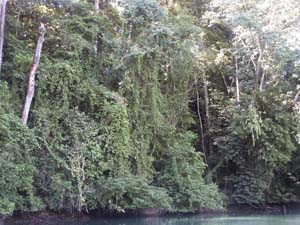 They offered a deck hand to wash the boat and he did a most immaculate
job cleaning out every grain of dirt and salt that had lodged itself since we
left Dana Point. They offered a deck hand to wash the boat and he did a most immaculate
job cleaning out every grain of dirt and salt that had lodged itself since we
left Dana Point.
Steve said he was not in competition with Banana Bay but
his intention was to get most of his draw from the sports fishers. He said the
owner of Banana Bay was a friend and had a house next door to him. Steve
proudly showed us the marina, restaurant, bar and the rooms that are available
for clients that fly down just for fishing. He was very proud of the handy work
that he had done. All the guest room doors had hand carved bill fish on them
and the chairs, barstools and tables were all custom made. Steve made sure
that we were comfortable and offered to help us with anything we needed. He
made several day trip suggestions that he could make arrangements for, etc. It
was way more than we expected.
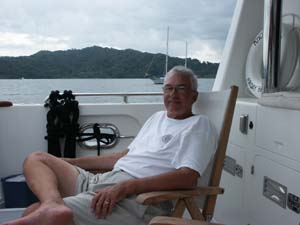 We had a couple days to rest. We wanted to get the boat
clean and orderly for our new guests. We were lucky because the restaurant had
just opened three days ago so we had several delicious meals there mostly
prepared solely for us. Steve had his staff trained to be friendly and
attentive to our every need. I think heís doing everything right. We had a couple days to rest. We wanted to get the boat
clean and orderly for our new guests. We were lucky because the restaurant had
just opened three days ago so we had several delicious meals there mostly
prepared solely for us. Steve had his staff trained to be friendly and
attentive to our every need. I think heís doing everything right.
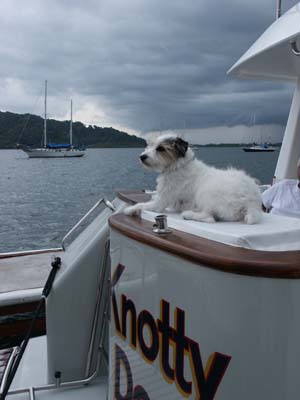
Our first meal that evening was accompanied by a tremendous
downpour that almost blew our tablecloth across the room. We literally had to
hold it down through dinner with strategically place candles, salt and pepper
shakers and our arms if we got an especially good blow. The clouds blew in and
the wind, lightening and thunder were a site and sound to behold.
Ziggy had the run of the place and was welcome under the
table at meals. We were able to get our complete load of laundry done and
delivered to us. So, for any of you yachters out there, and havenít heard about
this place, this is a find. Itís not advertised and itís difficult to get the
phone number because none of the locals seem to offer much info about it,
perhaps because of some loyalty to the Banana Boat Marina. Itís small and
charges less that Banana Bay, but that wonít last long.
The town itself, is run down, and the people at first
glance do not seem friendly like previous places weíve been.
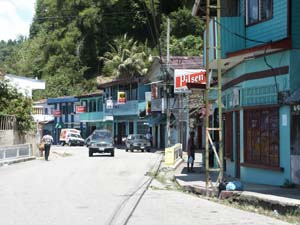 The bones of the
town have a lot of charm. The United Fruit Company established itself here back
in 1938. It saw its potential as a natural port and they built a major dock and
offices here in this wilderness. It drew Costa Ricans from all over the country
here seeking employment. Itís white fleet of banana boats shipped out 90
percent of Costa Ricaís bananas from here. Golfito quickly became a boomtown
supposedly filled with brothels, smugglers and drunks. It still has that feel
to it today. Apparently there was a lot of corruption within the banana company
and great amounts of money were being funneled into the US stock market. It
left a bad taste with the Ticos for Americans. After many labor strikes and
conflicts, the United Fruit Company closed down leaving behind economic
depression and many interesting buildings. The bones of the
town have a lot of charm. The United Fruit Company established itself here back
in 1938. It saw its potential as a natural port and they built a major dock and
offices here in this wilderness. It drew Costa Ricans from all over the country
here seeking employment. Itís white fleet of banana boats shipped out 90
percent of Costa Ricaís bananas from here. Golfito quickly became a boomtown
supposedly filled with brothels, smugglers and drunks. It still has that feel
to it today. Apparently there was a lot of corruption within the banana company
and great amounts of money were being funneled into the US stock market. It
left a bad taste with the Ticos for Americans. After many labor strikes and
conflicts, the United Fruit Company closed down leaving behind economic
depression and many interesting buildings.
Recently, there has been a slow comeback. They have built
a large ďDuty FeeĒ zone down by the port, which draws Costa Ricans from all over
to purchase TVs, refrigerators, etc. In order to be able to purchase from the
Duty Free Zone, the town requires that you register 24 hours ahead. This means
that visitors must stay overnight.
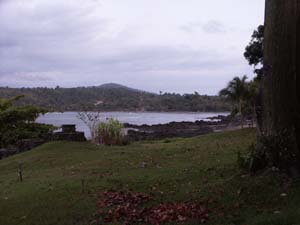 So an increase in accommodations was
required and these visitors also spend money in restaurants before they can buy
their purchases at the duty free. Many of the old charming buildings left over
by the United Fruit Company have been turned into rentable cabanas for this very
purpose. We took a cab to see the duty free zone. The entrance was cluttered
with small vendors selling t-shirts, watches, cell phones, drinks, fruits, and
snacks. As we wondered through the vendorís stall the people are very curious
about you and follow you around asking about Ziggy and just trying to have small
talk with you. Inside it looked like you were going through ďcustomsĒ at the
airport. There were rows and rows of aisles with metal railings. People were
lined up in these rows with their dollies carrying out refrigerators, washers
and dryers, etc. After they went through this ďcheck outĒ process, they would
then head out to the street and load their huge load of purchases into taxis. It
was an interesting sight. You also noticed the many men hanging around without
jobs. That made me nervous worrying about being mugged or pick pocketed.
Looked like they had a lot of unemployment. So an increase in accommodations was
required and these visitors also spend money in restaurants before they can buy
their purchases at the duty free. Many of the old charming buildings left over
by the United Fruit Company have been turned into rentable cabanas for this very
purpose. We took a cab to see the duty free zone. The entrance was cluttered
with small vendors selling t-shirts, watches, cell phones, drinks, fruits, and
snacks. As we wondered through the vendorís stall the people are very curious
about you and follow you around asking about Ziggy and just trying to have small
talk with you. Inside it looked like you were going through ďcustomsĒ at the
airport. There were rows and rows of aisles with metal railings. People were
lined up in these rows with their dollies carrying out refrigerators, washers
and dryers, etc. After they went through this ďcheck outĒ process, they would
then head out to the street and load their huge load of purchases into taxis. It
was an interesting sight. You also noticed the many men hanging around without
jobs. That made me nervous worrying about being mugged or pick pocketed.
Looked like they had a lot of unemployment.
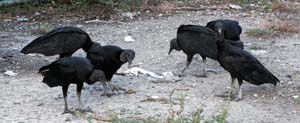 The town boasts a hospital, high school, grade school, and
the University of Costa Rica. All are housed in the old United Fruit Company
buildings, which have tin roofs, build on stilts, and shutter awnings over the
windows and doors with large walk around porches. Green lawns and beautiful
palm trees with white painted trunks surround all the buildings. So much
potential for fixing up. In fact, the owners of both marinas now live and own
houses that were formerly owned by the ex CEO, and CFO of the old United Fruit
Company. They are beautiful old houses that they have meticulously restored.
They are situated up on the hillier side of town with the jungle as their back
yard. As you toured this neighborhood you can notice the lowering tiers of
hierarchy of housing. Each street as it got closer to the waterfront were owned
or occupied by employees of lower importance in the company. They are fixing
them up to the grandeur of the old days. They have large areas of land that are
all perfectly manicured and some have swimming pools and exotic birds in large
arboretums. All this behind tall barbwire fences, flood lights with sensors and
guard dogs. The town boasts a hospital, high school, grade school, and
the University of Costa Rica. All are housed in the old United Fruit Company
buildings, which have tin roofs, build on stilts, and shutter awnings over the
windows and doors with large walk around porches. Green lawns and beautiful
palm trees with white painted trunks surround all the buildings. So much
potential for fixing up. In fact, the owners of both marinas now live and own
houses that were formerly owned by the ex CEO, and CFO of the old United Fruit
Company. They are beautiful old houses that they have meticulously restored.
They are situated up on the hillier side of town with the jungle as their back
yard. As you toured this neighborhood you can notice the lowering tiers of
hierarchy of housing. Each street as it got closer to the waterfront were owned
or occupied by employees of lower importance in the company. They are fixing
them up to the grandeur of the old days. They have large areas of land that are
all perfectly manicured and some have swimming pools and exotic birds in large
arboretums. All this behind tall barbwire fences, flood lights with sensors and
guard dogs.
There is a large pier set up for freighter or I think in
the future, cruise ship landing. You can still see some of the rail tracks for
the old steam engines that transported the bananas. We even found some of the
old trains in falling down warehouses, slowly decomposing by the jungle
environment. The Pueblo Civil, is the old downtown area, and the small road of
this area wind up the short hillside. It is filled with old small shops, bars,
and brothels, dating from the early 1900ís. We purchased fruit from one and the
counters were old and antique but charming. They love to help you pick out the
freshest and best fruit. Interestingly the meat shop was in the same room. We
watched as they cut the meat to order in the open air on wooden counters.
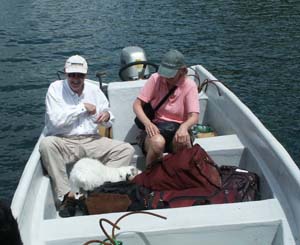
The longer you stayed the more you discovered and the more
comfortable you become in this rough and tumble environment. Steve was pointing
out a fellow staying at the marina one night who has investors that are putting
in 400 million to redevelop some of the area. This is like the old Key West but
not for long.
After a few days, our soon to be partners for this next leg
of our adventure arrived in a small rustic ponga from a resort miles away. We
were glad that they were here and as they were. We had not seen each other over
two years when we met them cruising Alaska. We donít know each other all that
well having only a couple occasions having dinner in Alaska and having only a
few emails and phone conversations in the last months planning this adventure.
We knew they were in the Golfito area the last few days and thought we would
hear from them sooner.
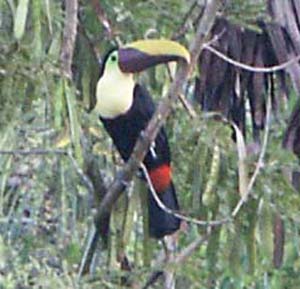 They were at a remote lodge and had difficulty finding
anyone that knew about the new marina or pretended they didnít know because they
were friends with Banana Bay. They were relieved to find that we were here
since they couldnít get any confirmation the last few days. They were at a remote lodge and had difficulty finding
anyone that knew about the new marina or pretended they didnít know because they
were friends with Banana Bay. They were relieved to find that we were here
since they couldnít get any confirmation the last few days.
The next day, Dave Wyman arrived, not without some
difficulty also. Apparently, the Golfito airport closed for repairs the day he
was to fly in and he had to fly to another village 30 miles away. He had a
30-mile pot holed ride in a taxi going way too fast in the terrible heat. He
was starved when he arrived so we all went to Banana Bay Marina for lunch to get
Dave food and refreshment. Dave, our friend from Santa Barbara, a very
experienced yachtsman, is joining us to help us through the canal, the San Blas
Islands, and will be leaving from the small island in the Caribbean called San
Andres. Heíll be flying straight to San Jose, Costa Rica and then to LA, then
to Santa Barbara. Apparently, the Golfito airport closed for repairs the day he
was to fly in and he had to fly to another village 30 miles away. He had a
30-mile pot holed ride in a taxi going way too fast in the terrible heat. He
was starved when he arrived so we all went to Banana Bay Marina for lunch to get
Dave food and refreshment. Dave, our friend from Santa Barbara, a very
experienced yachtsman, is joining us to help us through the canal, the San Blas
Islands, and will be leaving from the small island in the Caribbean called San
Andres. Heíll be flying straight to San Jose, Costa Rica and then to LA, then
to Santa Barbara.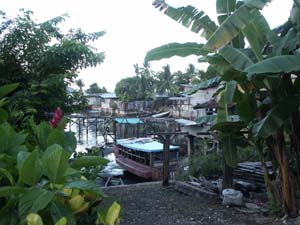
Banana Bay Marina is more laid back than K&B. Itís rustic
in nature and reminds me of what Key West might have been back in the old days.
There are yachters that arrive and never seem to leave. They just kind of hang
out or drop out here. They hang around the bar and exchange sea stories. The
marina has a resident white and brown large boxer that greets every new boat and
sits on the dock staring the new boat down until it registers and pays itís
fee.
 No kidding! The owner makes you feel right at home and the Tico lady takes
your order and slowly delivers it. There are two Jacuzzi tubs right by the bar
that sit up high on the dock (who would want to take a Jacuzzi in this heat?).
They have a small Internet and gift shop with a few bottles of boat wash, and a
couple filters. Very limited. The restaurant was much cheaper and more casual
than K&B so it was good for lunch and casual dinners. No kidding! The owner makes you feel right at home and the Tico lady takes
your order and slowly delivers it. There are two Jacuzzi tubs right by the bar
that sit up high on the dock (who would want to take a Jacuzzi in this heat?).
They have a small Internet and gift shop with a few bottles of boat wash, and a
couple filters. Very limited. The restaurant was much cheaper and more casual
than K&B so it was good for lunch and casual dinners.
There are dogs everywhere in this town.  Ziggy goes
everywhere and is welcome everywhere. One night we asked Steve to recommend
another place to have dinner, since we didnít see any place that looked good in
our travels through town. He recommended ďMikeís PlaceĒ, owned by an old
Hungarian guy and his wife. Itís a bit out of town and the steaks are supposed
to be great. Steve offered to drive us out that night and dropped all of us
off. The place looked like a rundown shack. Ziggy goes
everywhere and is welcome everywhere. One night we asked Steve to recommend
another place to have dinner, since we didnít see any place that looked good in
our travels through town. He recommended ďMikeís PlaceĒ, owned by an old
Hungarian guy and his wife. Itís a bit out of town and the steaks are supposed
to be great. Steve offered to drive us out that night and dropped all of us
off. The place looked like a rundown shack. 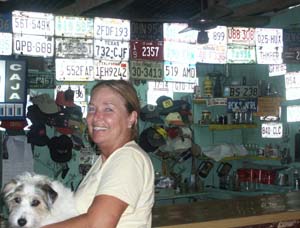 It had an old rotting sign out
front that said ďArgentinean RestaurantĒ T-bones. Inside was a crummy run down
old bar with American car license plates nailed to the walls. A big old grey
haired guy pointed poked his head out from a door and pointed us into the back
room. We wandered our way through some not took attractive doorways which
finally opened onto a tiled patio with a roof. There were now walls as it was
open to the pitch-black night and jungle. All through dinner, we could hear
were the screeches of the night animals. It had an old rotting sign out
front that said ďArgentinean RestaurantĒ T-bones. Inside was a crummy run down
old bar with American car license plates nailed to the walls. A big old grey
haired guy pointed poked his head out from a door and pointed us into the back
room. We wandered our way through some not took attractive doorways which
finally opened onto a tiled patio with a roof. There were now walls as it was
open to the pitch-black night and jungle. All through dinner, we could hear
were the screeches of the night animals.
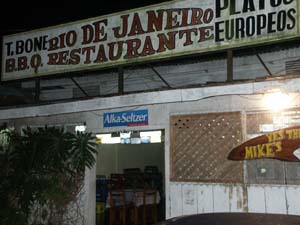 The furniture was very simple homemade
wood block tables and chairs with vinyl table clothes and simple candleholders
made from whatever was around. Mikeís Tico wife came out and greeted us with a
big smile. Her English wasnít so good but we managed to order some drinks. In
her broken English, she told us what they had for tonight: T-bone steak, ribs,
and stuffed peppers. We ordered drinks and dinner and began the wait. Steve
had warned us that there is no rush here, it comes when it comes but when it
gets there itís great. As we sat the place filled up, obviously a popular
hangout with Expats and yachters. My steak was the best steak I can remember
and I had enough left over for Ziggy. Richard had not been feeling too well,
had some kind of bowel problem so didnít eat much. He also didnít like where we
were sitting, so after trying a couple tables, we settled back in the first
table. This restaurant was a fun place and a memorable experience. The furniture was very simple homemade
wood block tables and chairs with vinyl table clothes and simple candleholders
made from whatever was around. Mikeís Tico wife came out and greeted us with a
big smile. Her English wasnít so good but we managed to order some drinks. In
her broken English, she told us what they had for tonight: T-bone steak, ribs,
and stuffed peppers. We ordered drinks and dinner and began the wait. Steve
had warned us that there is no rush here, it comes when it comes but when it
gets there itís great. As we sat the place filled up, obviously a popular
hangout with Expats and yachters. My steak was the best steak I can remember
and I had enough left over for Ziggy. Richard had not been feeling too well,
had some kind of bowel problem so didnít eat much. He also didnít like where we
were sitting, so after trying a couple tables, we settled back in the first
table. This restaurant was a fun place and a memorable experience.
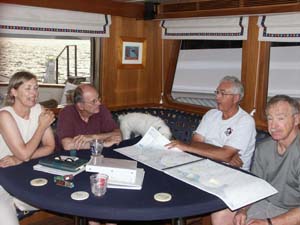 The next day we all sat down and planned our trip for the
next few days. Larry had made different calculations with various stops that
would eventually land us into Panama City. We wanted to stop at Isla Secas for
sure and then everything else was up for grabs. We decided weíd head the next
day about 2:00 PM after Larry got the clearance papers done. This would put us
into Isla Secas mid morning just right for the tide so we could get the dinghy
ashore before the coral reef would be exposed and too shallow for the dinghy to
go through. Our plan was to spend a few hours seeing the island, snorkel, then
head for our night anchorage in Bahia Honda, Panama. The next morning we would
leave at 5:00 AM doing an all-day, all-nighter, putting us into Panama City at
5:00 or 6:00 AM. Larry then gave a tour of everything on the boat and the
procedures for doing watch and engine room checks. The next day we all sat down and planned our trip for the
next few days. Larry had made different calculations with various stops that
would eventually land us into Panama City. We wanted to stop at Isla Secas for
sure and then everything else was up for grabs. We decided weíd head the next
day about 2:00 PM after Larry got the clearance papers done. This would put us
into Isla Secas mid morning just right for the tide so we could get the dinghy
ashore before the coral reef would be exposed and too shallow for the dinghy to
go through. Our plan was to spend a few hours seeing the island, snorkel, then
head for our night anchorage in Bahia Honda, Panama. The next morning we would
leave at 5:00 AM doing an all-day, all-nighter, putting us into Panama City at
5:00 or 6:00 AM. Larry then gave a tour of everything on the boat and the
procedures for doing watch and engine room checks.
We made a few last minute visits to downtown Golfito to
pick up some t-shirts, go to the internet cafť, provision at the
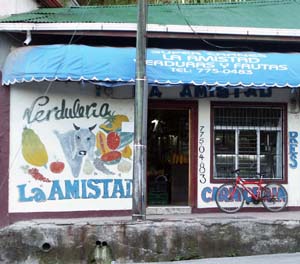 ďsuper
MercadoĒ, and to stop at the ice cream shop that we discovered. The heat is so
unbearable and the humidity makes you sweat so much that you really canít
accomplish much in a day but we got everything ready for our first adventure
together. Now on to Panama ďsuper
MercadoĒ, and to stop at the ice cream shop that we discovered. The heat is so
unbearable and the humidity makes you sweat so much that you really canít
accomplish much in a day but we got everything ready for our first adventure
together. Now on to Panama
|
 An Expat owns it, a
young guy in his 30ís, and he provides all the conveniences for cruisers that
they havenít been able to get for a very long haul on this coast. The wooden
docks are a bit rickety and they have a simple open-air restaurant and bar that
looks a little worn. But he provides a warm welcome like youíve reached home
and the pluses are Internet services, fuel, power, water, a few simple rooms to
rent and a couple hot tubs right next to the restaurant/bar. We didnít head for
Banana Bay though as we couldnít get a confirmation back on email to reserve a
slip space. We headed instead at a brand new marina next door called K&B. We
had heard about K& B from a sports fisher in Los Suenos. It was the new upscale
version with concrete docks and tin roof that covered the dock paths, power to
blast off, water, and fine dining and the prettiest girls to run the bar and
restaurant service that Iíve seen since weíve come South of the border. The
restaurant had only been open 3 days when we arrived. K&B claims itís not in
competition with Banana Bay but the longer our stay the more we sensed some
tension between the two and their local followers, though we canít put our
finger on it.
An Expat owns it, a
young guy in his 30ís, and he provides all the conveniences for cruisers that
they havenít been able to get for a very long haul on this coast. The wooden
docks are a bit rickety and they have a simple open-air restaurant and bar that
looks a little worn. But he provides a warm welcome like youíve reached home
and the pluses are Internet services, fuel, power, water, a few simple rooms to
rent and a couple hot tubs right next to the restaurant/bar. We didnít head for
Banana Bay though as we couldnít get a confirmation back on email to reserve a
slip space. We headed instead at a brand new marina next door called K&B. We
had heard about K& B from a sports fisher in Los Suenos. It was the new upscale
version with concrete docks and tin roof that covered the dock paths, power to
blast off, water, and fine dining and the prettiest girls to run the bar and
restaurant service that Iíve seen since weíve come South of the border. The
restaurant had only been open 3 days when we arrived. K&B claims itís not in
competition with Banana Bay but the longer our stay the more we sensed some
tension between the two and their local followers, though we canít put our
finger on it.  The small marina (it had only one pier) was really the
nicest thing weíve seen since Los Suenos though not on the same scale. A young
man (Steve) from Maine runs the place. Heís a tall nice looking guy and was
busy taking care of his two daughters, the family dog, running the small marina,
and showing us all the facilities. He was a former mechanical engineer for
tugboats in Maine and Massachusetts. He said a money backer offered he and his
family the opportunity to build this marina and live down here. His wife was
away in Maine on our visit taking care of final arrangements on the sale of
their house. Steve said he and three guys built every piece of the marina,
which included the furniture. We had all the power and wash down water we
needed.
The small marina (it had only one pier) was really the
nicest thing weíve seen since Los Suenos though not on the same scale. A young
man (Steve) from Maine runs the place. Heís a tall nice looking guy and was
busy taking care of his two daughters, the family dog, running the small marina,
and showing us all the facilities. He was a former mechanical engineer for
tugboats in Maine and Massachusetts. He said a money backer offered he and his
family the opportunity to build this marina and live down here. His wife was
away in Maine on our visit taking care of final arrangements on the sale of
their house. Steve said he and three guys built every piece of the marina,
which included the furniture. We had all the power and wash down water we
needed.
 They offered a deck hand to wash the boat and he did a most immaculate
job cleaning out every grain of dirt and salt that had lodged itself since we
left Dana Point.
They offered a deck hand to wash the boat and he did a most immaculate
job cleaning out every grain of dirt and salt that had lodged itself since we
left Dana Point. We had a couple days to rest. We wanted to get the boat
clean and orderly for our new guests. We were lucky because the restaurant had
just opened three days ago so we had several delicious meals there mostly
prepared solely for us. Steve had his staff trained to be friendly and
attentive to our every need. I think heís doing everything right.
We had a couple days to rest. We wanted to get the boat
clean and orderly for our new guests. We were lucky because the restaurant had
just opened three days ago so we had several delicious meals there mostly
prepared solely for us. Steve had his staff trained to be friendly and
attentive to our every need. I think heís doing everything right.

 The bones of the
town have a lot of charm. The United Fruit Company established itself here back
in 1938. It saw its potential as a natural port and they built a major dock and
offices here in this wilderness. It drew Costa Ricans from all over the country
here seeking employment. Itís white fleet of banana boats shipped out 90
percent of Costa Ricaís bananas from here. Golfito quickly became a boomtown
supposedly filled with brothels, smugglers and drunks. It still has that feel
to it today. Apparently there was a lot of corruption within the banana company
and great amounts of money were being funneled into the US stock market. It
left a bad taste with the Ticos for Americans. After many labor strikes and
conflicts, the United Fruit Company closed down leaving behind economic
depression and many interesting buildings.
The bones of the
town have a lot of charm. The United Fruit Company established itself here back
in 1938. It saw its potential as a natural port and they built a major dock and
offices here in this wilderness. It drew Costa Ricans from all over the country
here seeking employment. Itís white fleet of banana boats shipped out 90
percent of Costa Ricaís bananas from here. Golfito quickly became a boomtown
supposedly filled with brothels, smugglers and drunks. It still has that feel
to it today. Apparently there was a lot of corruption within the banana company
and great amounts of money were being funneled into the US stock market. It
left a bad taste with the Ticos for Americans. After many labor strikes and
conflicts, the United Fruit Company closed down leaving behind economic
depression and many interesting buildings. So an increase in accommodations was
required and these visitors also spend money in restaurants before they can buy
their purchases at the duty free. Many of the old charming buildings left over
by the United Fruit Company have been turned into rentable cabanas for this very
purpose. We took a cab to see the duty free zone. The entrance was cluttered
with small vendors selling t-shirts, watches, cell phones, drinks, fruits, and
snacks. As we wondered through the vendorís stall the people are very curious
about you and follow you around asking about Ziggy and just trying to have small
talk with you. Inside it looked like you were going through ďcustomsĒ at the
airport. There were rows and rows of aisles with metal railings. People were
lined up in these rows with their dollies carrying out refrigerators, washers
and dryers, etc. After they went through this ďcheck outĒ process, they would
then head out to the street and load their huge load of purchases into taxis. It
was an interesting sight. You also noticed the many men hanging around without
jobs. That made me nervous worrying about being mugged or pick pocketed.
Looked like they had a lot of unemployment.
So an increase in accommodations was
required and these visitors also spend money in restaurants before they can buy
their purchases at the duty free. Many of the old charming buildings left over
by the United Fruit Company have been turned into rentable cabanas for this very
purpose. We took a cab to see the duty free zone. The entrance was cluttered
with small vendors selling t-shirts, watches, cell phones, drinks, fruits, and
snacks. As we wondered through the vendorís stall the people are very curious
about you and follow you around asking about Ziggy and just trying to have small
talk with you. Inside it looked like you were going through ďcustomsĒ at the
airport. There were rows and rows of aisles with metal railings. People were
lined up in these rows with their dollies carrying out refrigerators, washers
and dryers, etc. After they went through this ďcheck outĒ process, they would
then head out to the street and load their huge load of purchases into taxis. It
was an interesting sight. You also noticed the many men hanging around without
jobs. That made me nervous worrying about being mugged or pick pocketed.
Looked like they had a lot of unemployment. The town boasts a hospital, high school, grade school, and
the University of Costa Rica. All are housed in the old United Fruit Company
buildings, which have tin roofs, build on stilts, and shutter awnings over the
windows and doors with large walk around porches. Green lawns and beautiful
palm trees with white painted trunks surround all the buildings. So much
potential for fixing up. In fact, the owners of both marinas now live and own
houses that were formerly owned by the ex CEO, and CFO of the old United Fruit
Company. They are beautiful old houses that they have meticulously restored.
They are situated up on the hillier side of town with the jungle as their back
yard. As you toured this neighborhood you can notice the lowering tiers of
hierarchy of housing. Each street as it got closer to the waterfront were owned
or occupied by employees of lower importance in the company. They are fixing
them up to the grandeur of the old days. They have large areas of land that are
all perfectly manicured and some have swimming pools and exotic birds in large
arboretums. All this behind tall barbwire fences, flood lights with sensors and
guard dogs.
The town boasts a hospital, high school, grade school, and
the University of Costa Rica. All are housed in the old United Fruit Company
buildings, which have tin roofs, build on stilts, and shutter awnings over the
windows and doors with large walk around porches. Green lawns and beautiful
palm trees with white painted trunks surround all the buildings. So much
potential for fixing up. In fact, the owners of both marinas now live and own
houses that were formerly owned by the ex CEO, and CFO of the old United Fruit
Company. They are beautiful old houses that they have meticulously restored.
They are situated up on the hillier side of town with the jungle as their back
yard. As you toured this neighborhood you can notice the lowering tiers of
hierarchy of housing. Each street as it got closer to the waterfront were owned
or occupied by employees of lower importance in the company. They are fixing
them up to the grandeur of the old days. They have large areas of land that are
all perfectly manicured and some have swimming pools and exotic birds in large
arboretums. All this behind tall barbwire fences, flood lights with sensors and
guard dogs.
 They were at a remote lodge and had difficulty finding
anyone that knew about the new marina or pretended they didnít know because they
were friends with Banana Bay. They were relieved to find that we were here
since they couldnít get any confirmation the last few days.
They were at a remote lodge and had difficulty finding
anyone that knew about the new marina or pretended they didnít know because they
were friends with Banana Bay. They were relieved to find that we were here
since they couldnít get any confirmation the last few days.  Apparently, the Golfito airport closed for repairs the day he
was to fly in and he had to fly to another village 30 miles away. He had a
30-mile pot holed ride in a taxi going way too fast in the terrible heat. He
was starved when he arrived so we all went to Banana Bay Marina for lunch to get
Dave food and refreshment. Dave, our friend from Santa Barbara, a very
experienced yachtsman, is joining us to help us through the canal, the San Blas
Islands, and will be leaving from the small island in the Caribbean called San
Andres. Heíll be flying straight to San Jose, Costa Rica and then to LA, then
to Santa Barbara.
Apparently, the Golfito airport closed for repairs the day he
was to fly in and he had to fly to another village 30 miles away. He had a
30-mile pot holed ride in a taxi going way too fast in the terrible heat. He
was starved when he arrived so we all went to Banana Bay Marina for lunch to get
Dave food and refreshment. Dave, our friend from Santa Barbara, a very
experienced yachtsman, is joining us to help us through the canal, the San Blas
Islands, and will be leaving from the small island in the Caribbean called San
Andres. Heíll be flying straight to San Jose, Costa Rica and then to LA, then
to Santa Barbara.
 No kidding! The owner makes you feel right at home and the Tico lady takes
your order and slowly delivers it. There are two Jacuzzi tubs right by the bar
that sit up high on the dock (who would want to take a Jacuzzi in this heat?).
They have a small Internet and gift shop with a few bottles of boat wash, and a
couple filters. Very limited. The restaurant was much cheaper and more casual
than K&B so it was good for lunch and casual dinners.
No kidding! The owner makes you feel right at home and the Tico lady takes
your order and slowly delivers it. There are two Jacuzzi tubs right by the bar
that sit up high on the dock (who would want to take a Jacuzzi in this heat?).
They have a small Internet and gift shop with a few bottles of boat wash, and a
couple filters. Very limited. The restaurant was much cheaper and more casual
than K&B so it was good for lunch and casual dinners.  Ziggy goes
everywhere and is welcome everywhere. One night we asked Steve to recommend
another place to have dinner, since we didnít see any place that looked good in
our travels through town. He recommended ďMikeís PlaceĒ, owned by an old
Hungarian guy and his wife. Itís a bit out of town and the steaks are supposed
to be great. Steve offered to drive us out that night and dropped all of us
off. The place looked like a rundown shack.
Ziggy goes
everywhere and is welcome everywhere. One night we asked Steve to recommend
another place to have dinner, since we didnít see any place that looked good in
our travels through town. He recommended ďMikeís PlaceĒ, owned by an old
Hungarian guy and his wife. Itís a bit out of town and the steaks are supposed
to be great. Steve offered to drive us out that night and dropped all of us
off. The place looked like a rundown shack.  It had an old rotting sign out
front that said ďArgentinean RestaurantĒ T-bones. Inside was a crummy run down
old bar with American car license plates nailed to the walls. A big old grey
haired guy pointed poked his head out from a door and pointed us into the back
room. We wandered our way through some not took attractive doorways which
finally opened onto a tiled patio with a roof. There were now walls as it was
open to the pitch-black night and jungle. All through dinner, we could hear
were the screeches of the night animals.
It had an old rotting sign out
front that said ďArgentinean RestaurantĒ T-bones. Inside was a crummy run down
old bar with American car license plates nailed to the walls. A big old grey
haired guy pointed poked his head out from a door and pointed us into the back
room. We wandered our way through some not took attractive doorways which
finally opened onto a tiled patio with a roof. There were now walls as it was
open to the pitch-black night and jungle. All through dinner, we could hear
were the screeches of the night animals.
 The furniture was very simple homemade
wood block tables and chairs with vinyl table clothes and simple candleholders
made from whatever was around. Mikeís Tico wife came out and greeted us with a
big smile. Her English wasnít so good but we managed to order some drinks. In
her broken English, she told us what they had for tonight: T-bone steak, ribs,
and stuffed peppers. We ordered drinks and dinner and began the wait. Steve
had warned us that there is no rush here, it comes when it comes but when it
gets there itís great. As we sat the place filled up, obviously a popular
hangout with Expats and yachters. My steak was the best steak I can remember
and I had enough left over for Ziggy. Richard had not been feeling too well,
had some kind of bowel problem so didnít eat much. He also didnít like where we
were sitting, so after trying a couple tables, we settled back in the first
table. This restaurant was a fun place and a memorable experience.
The furniture was very simple homemade
wood block tables and chairs with vinyl table clothes and simple candleholders
made from whatever was around. Mikeís Tico wife came out and greeted us with a
big smile. Her English wasnít so good but we managed to order some drinks. In
her broken English, she told us what they had for tonight: T-bone steak, ribs,
and stuffed peppers. We ordered drinks and dinner and began the wait. Steve
had warned us that there is no rush here, it comes when it comes but when it
gets there itís great. As we sat the place filled up, obviously a popular
hangout with Expats and yachters. My steak was the best steak I can remember
and I had enough left over for Ziggy. Richard had not been feeling too well,
had some kind of bowel problem so didnít eat much. He also didnít like where we
were sitting, so after trying a couple tables, we settled back in the first
table. This restaurant was a fun place and a memorable experience. The next day we all sat down and planned our trip for the
next few days. Larry had made different calculations with various stops that
would eventually land us into Panama City. We wanted to stop at Isla Secas for
sure and then everything else was up for grabs. We decided weíd head the next
day about 2:00 PM after Larry got the clearance papers done. This would put us
into Isla Secas mid morning just right for the tide so we could get the dinghy
ashore before the coral reef would be exposed and too shallow for the dinghy to
go through. Our plan was to spend a few hours seeing the island, snorkel, then
head for our night anchorage in Bahia Honda, Panama. The next morning we would
leave at 5:00 AM doing an all-day, all-nighter, putting us into Panama City at
5:00 or 6:00 AM. Larry then gave a tour of everything on the boat and the
procedures for doing watch and engine room checks.
The next day we all sat down and planned our trip for the
next few days. Larry had made different calculations with various stops that
would eventually land us into Panama City. We wanted to stop at Isla Secas for
sure and then everything else was up for grabs. We decided weíd head the next
day about 2:00 PM after Larry got the clearance papers done. This would put us
into Isla Secas mid morning just right for the tide so we could get the dinghy
ashore before the coral reef would be exposed and too shallow for the dinghy to
go through. Our plan was to spend a few hours seeing the island, snorkel, then
head for our night anchorage in Bahia Honda, Panama. The next morning we would
leave at 5:00 AM doing an all-day, all-nighter, putting us into Panama City at
5:00 or 6:00 AM. Larry then gave a tour of everything on the boat and the
procedures for doing watch and engine room checks.  ďsuper
MercadoĒ, and to stop at the ice cream shop that we discovered. The heat is so
unbearable and the humidity makes you sweat so much that you really canít
accomplish much in a day but we got everything ready for our first adventure
together. Now on to
ďsuper
MercadoĒ, and to stop at the ice cream shop that we discovered. The heat is so
unbearable and the humidity makes you sweat so much that you really canít
accomplish much in a day but we got everything ready for our first adventure
together. Now on to